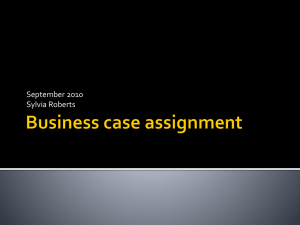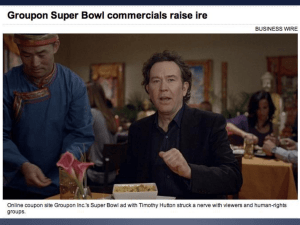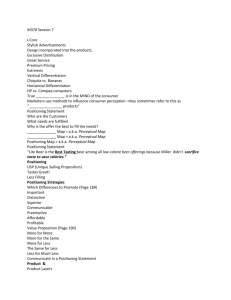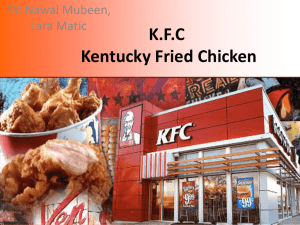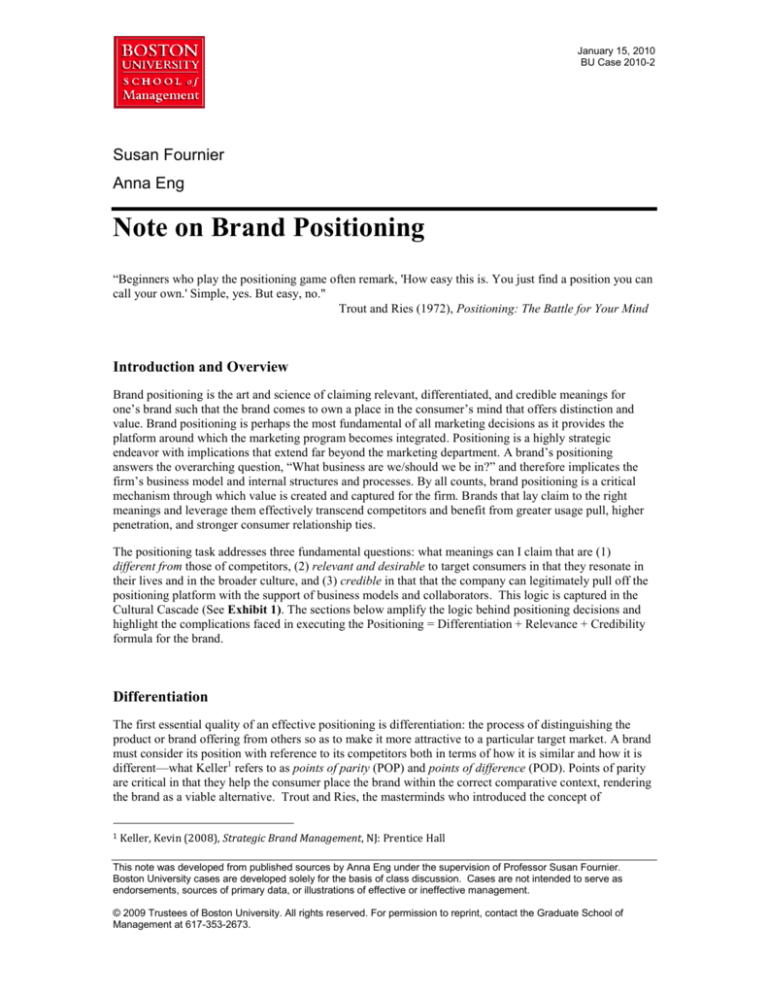
January 15, 2010
BU Case 2010-2
Susan Fournier
Anna Eng
Note on Brand Positioning
“Beginners who play the positioning game often remark, 'How easy this is. You just find a position you can
call your own.' Simple, yes. But easy, no."
Trout and Ries (1972), Positioning: The Battle for Your Mind
Introduction and Overview
Brand positioning is the art and science of claiming relevant, differentiated, and credible meanings for
one’s brand such that the brand comes to own a place in the consumer’s mind that offers distinction and
value. Brand positioning is perhaps the most fundamental of all marketing decisions as it provides the
platform around which the marketing program becomes integrated. Positioning is a highly strategic
endeavor with implications that extend far beyond the marketing department. A brand’s positioning
answers the overarching question, “What business are we/should we be in?” and therefore implicates the
firm’s business model and internal structures and processes. By all counts, brand positioning is a critical
mechanism through which value is created and captured for the firm. Brands that lay claim to the right
meanings and leverage them effectively transcend competitors and benefit from greater usage pull, higher
penetration, and stronger consumer relationship ties.
The positioning task addresses three fundamental questions: what meanings can I claim that are (1)
different from those of competitors, (2) relevant and desirable to target consumers in that they resonate in
their lives and in the broader culture, and (3) credible in that that the company can legitimately pull off the
positioning platform with the support of business models and collaborators. This logic is captured in the
Cultural Cascade (See Exhibit 1). The sections below amplify the logic behind positioning decisions and
highlight the complications faced in executing the Positioning = Differentiation + Relevance + Credibility
formula for the brand.
Differentiation
The first essential quality of an effective positioning is differentiation: the process of distinguishing the
product or brand offering from others so as to make it more attractive to a particular target market. A brand
must consider its position with reference to its competitors both in terms of how it is similar and how it is
different—what Keller1 refers to as points of parity (POP) and points of difference (POD). Points of parity
are critical in that they help the consumer place the brand within the correct comparative context, rendering
the brand as a viable alternative. Trout and Ries, the masterminds who introduced the concept of
1
Keller, Kevin (2008), Strategic Brand Management, NJ: Prentice Hall
This note was developed from published sources by Anna Eng under the supervision of Professor Susan Fournier.
Boston University cases are developed solely for the basis of class discussion. Cases are not intended to serve as
endorsements, sources of primary data, or illustrations of effective or ineffective management.
© 2009 Trustees of Boston University. All rights reserved. For permission to reprint, contact the Graduate School of
Management at 617-353-2673.
Note on Classic Brand Positioning
positioning to the world of marketing, argue that points of parity are critical in a world where people have
scarce information processing resources and limited memory capacity. The mind has no room for the new
and different unless it’s related to the old, they argue. POPs allow a brand to climb onto “a ladder of
products that consumers have established in their minds.” In order to claim a space on the ladder, the
marketer relates his/her brand to others while avoiding head-to-head comparisons along attribute or benefit
lines.
Points of parity (POPs) can be categorical or competitive. Category POPs are associations that are
necessary in order to be seen as a credible offering in a particular product or service category. As an
example, consider that all laundry detergents must offer cleaning benefits, and all wines should taste great.
Competitive POPs are associations that make direct similarity references to key competitors, again to
stimulate the inference that the brand is a legitimate player in that space and to negate the competitor’s
claimed point of difference. As an example, consider that during a wave of diet and health trends, lite beers
emphasized the number of calories in a serving (about 95), although Guinness had always claimed 95
calories for its beer. By highlighting this in it’s advertising, Guinness pointed out that lite beers’ point of
difference was, in fact, not a point of difference at all. Avis provides a famously successful example of
using competitive points of parity to associate their brand with the category leader. Avis took on Hertz
with the slogan, “Avis is only No. 2 in rent-a-cars, so why go with us? We try harder.” By admitting it was
number two to Hertz, Avis associated itself with the category leader and was able to claim a spot on the
same “ladder.” Soft drink 7-Up also used competitive points of parity to establish their positioning. By
identifying itself as the “the uncola”, 7-Up climbed onto the soft drink product ladder to be considered
alongside Coke and Pepsi.
Points of difference (PODs) concern attributes, benefits, images, or values that people associate with one
brand and not others. PODs provide the consumer with a reason to buy a branded product that
competitors cannot match. The POD allows a brand to own a space that no other brand has yet to
occupy; it gives consumers a unique comparison point on which they can base their buying decisions
and establish loyalties to a brand. The notion of the sustainable competitive advantage –a firm’s
advantage in delivering superior value for a prolonged time—captures a similar notion. PODs may rely on
performance attributes (e.g., Dove products contain moisturizers; Wal-mart offers the lowest prices on
everyday products), performance benefits (e.g., Dove products do not dry your skin while they cleanse),
imagery associations (e.g., BMW is for the status-conscious; Volkswagen is for the people), or higher-level
values (Harley Davidson stands for freedom and independence). Without a point of difference, a brand is
rendered interchangeable and devolves to commodity status.
Frequently, managers stake their brand’s position on a point of difference that is not sustainable. Land
Rover once claimed seven-person seating for its Discovery brand, but this benefit was easily copied.
Furniture galleries compete in successively escalating cycles of improved service offerings over time.
Managers must take care to identify points of differentiation that can consistently deliver value to the firm
long-term.
Points of parity and points of difference are not alternative routes to differentiation: points of parity
are only useful if the brand claims a point of difference as well. Looking back at the Avis and 7-Up
examples, both brands associated themselves with leaders in a product category thereby establishing points
of parity, but both brands also established points of difference that set them apart. Avis’s positioning says
“yes, we are number two to Hertz, but we try harder.” 7-Up effectively established itself as the first
alternative to cola. The “uncola” is a soft drink, but it is not a cola beverage.
Another great example of using points of parity and points of difference is captured in the familiar Miller
Lite slogan from the 1980s: “Tastes great; Less filling.” The point of parity, “tastes great,” helped
consumers understand that Miller Lite had just as much flavor as its competitors. “Less filling” identified
the point of difference singling out Miller Lite to establish it as the only beer that wouldn’t fill you up.
Boston University Graduate School of Management
2
Note on Classic Brand Positioning
Relevance
In order for a position to be powerful, the brand must occupy not only a differentiated position, but also a
positioning that is relevant, resonant, and valuable both in the culture and in the consumer’s mind. It is not
enough to claim meanings that are different from competition since some such meanings may not matter to
people and the contemporary societies in which they live. The brand’s claimed meanings must also be
relevant: they must be somehow pertinent, connected, or applicable to the lives that people live.
When a company claims a positioning that is ignorant of the needs and desires of target consumers,
marketplace failure results. Consider R.J. Reynolds’ 1988 product introduction, Premier Smokeless
Cigarettes. The product failed miserably in test markets because the smokeless benefit didn’t appeal to the
target smokers, who valued the ritual of smoke as much as the regular supply of nicotine. More recently, in
an attempt to enhance the user experience, Phillips developed a flat screen television that projected ambient
light onto the wall behind the television. Unfortunately for Phillips, this technological difference did not
translate into a benefit that resonated with consumers. The same thing happened with Crystal Pepsi, a clear
cola with the same taste as Pepsi. The “no color” benefit held no relevance for consumers; Crystal Pepsi
failed after one year. Each of these examples provides differentiation, but it is meaningless differentiation
in the end.
Getting to meanings that resonate is by no means an easy task. In all of the examples above, management
arguably stayed too close to the product while ignoring the context of people’s lives. The criterion of
relevance forces you to go beyond the product attribute-level question, “what is it?” to the deeper question
“what of it?” in order to probe the brand’s connection within the person’s life. Relevance extends to the
deeper emotional and psychosocial benefits that a brand’s usage can obtain.
It is important to consider relevance at two levels: the personal and the socio-cultural. Personal resonance
considers how the brand makes you feel, what the brand really does for you, how the brand fits into who
you are and what’s important or pressing in your life. Cultural relevance is about fit within the broader
cultural context: whether the brand’s meanings matter in the context of the trends, themes, and tensions
operative in the social world. Successful brands “Braille” the culture to find those meanings that people
hunger for. They search for responsive chords in the culture: meanings that are seemingly missing but
yearned for in people’s personal and social lives.2
Some examples help clarify the notions of personal and cultural relevance by illuminating brands that
struck responsive cultural chords.
President Obama’s campaign focused relentlessly on new possibilities and new beginnings.
Change was something that America was hungry for after the Bush administration, and Obama
promised to deliver it.
Martha Stewart built an billion dollar empire by teaching people during the 1990’s Wall Street
boom years how to use their new-found money in a stylish, sophisticated manner. Stewart also
sold legitimacy in the tasks of homemaking to a group of career-driven women who had been
acculturated to leave that quest behind.
Apple capitalized on a 1970s cultural desire to triumph over the staid, regimented, corporate
mainstream, to a place where individual diversity and creativity reigned.
Harley-Davidson tapped into a deep American myth relating to freedom and rebellion: freedom
from conventions and restrictions, and freedom to be oneself.
Corona beat out competitors by connecting the brand to a key cultural story circulating in America
during the 1980’s: the raucous spring break party myth. The brand successfully rode this cultural
For a discussion of the cultural myth market, see also Holt, Douglas (2004), How Brands Become Icons: The
Principles of Cultural Branding, Boston: Harvard Business School Press.
2
Boston University Graduate School of Management
3
Note on Classic Brand Positioning
wave for nearly two decades, racking up sales as America’s party beer. When faced with a
collapse in sales, Corona evolved again with the culture, transitioning to the narrative of the “get
away from it all” vacation.
Informed segmentation and targeting are critical when identifying a resonant position for the brand. The
logic is simple: You cannot determine a brand’s potential relevance without knowing for whom the brand’s
meanings are supposed to matter in the end. Through segmentation, managers consider how a given
population can be split into sub-groups that are usefully differentiated from each other along lines relevant
to the category and the brand. Values, lifestyles, brand usage patterns, brand choice criteria, meanings, and
socio-demographics provide common bases along which segmentations can be created. During a time of
intense price wars, for example, Mobil successfully leveraged segmentation insights to go from a 10%
market share to a leadership position. Through consumer interviews, Mobil discovered that, contrary to
industry-wide beliefs, price was a concern for only a minority of the population. Management divided their
customer base in terms of behaviors and values related to gasoline and convenience store retail (see
Exhibit 2). By determining which needs were strongly held by the different consumer sub-groups, and how
those groups felt about the Mobil brand, management was able to identify a resonant brand positioning.
The new position focused on a “quality buying experience.” Mobil targeted heavier users labeled as Road
Warriors, True Blues, and Generation F3 by offering full service at no additional cost. The little extras were
highly valued by these segments, engendering increased loyalty to the brand.
Managers must continuously re-evaluate what benefits, meanings, and values resonate with their target
consumer. If consumers change or if the culture changes –and change they will—and the meanings behind
the positioning do not, a brand’s relevance will vanish. J&B Scotch offers an example of a firm that was
adept at finding meanings that resonated within an operative cultural stream (i.e., The Dean Martin/Frank
Sinatra Three Martini Lunch lifestyle), but failed to contemporize those meanings as the culture moved on.
Similarly, nearly 30 years after Martha Stewart founded her lifestyle, the cultural tides shifted to a simpler
aesthetic, and many moved on from the brand.
Credibility
The final criterion for effective positioning is that of credibility: the believability of the message, both in
terms of its objective and subjective claims. Again, a brand can claim resonant meanings that competitors
have left on the table, but if the company does not have the capabilities to back and deliver these meanings,
the exercise is for naught.
On the surface, the establishment of credibility and believability seems a straightforward, logical exercise
that considers the brand’s comparative performance on a specific product attribute claim. For example, a
breakfast cereal can easily prove that it is healthier than the competition by comparing data on nutrition
labels. Country Time Lemonade offers another clear-cut example. The brand had a successful launch built
on the brand promise that it tasted like good, old-fashioned lemonade. Minute Maid introduced its own
lemonade mix, pointing out that its product was made with the juice of twenty lemons. Country Time’s
flavor came from lemon peels, but this no longer mattered. Good old-fashioned lemonade was made with
real lemons; Minute Maid had won.
But, credibility involves issues much deeper than this comparative activity implies. True credibility is
delivered through business models aligned with and capable of supporting the brand promise. Credible
positioning emphasizes brand meanings that are woven into the company’s overall strategy. Credible
positioning rests on a supportive culture and enabling skill sets. A credible positioning is one that the
organization is able to execute and solidly stand behind.
Samsung, a once dying brand with an aging portfolio in the fast-paced world of consumer electronics,
provides a powerful example of the type of strategic integration that needs to support the positioning of the
brand for it to be successful. Samsung’s CEO, recognizing the need for innovative new products that could
be quickly brought to market, championed a positioning of “innovation with style.” The CEO led a major
Boston University Graduate School of Management
4
Note on Classic Brand Positioning
restructuring effort to bring the company’s business model in line. The company increased R&D spending
dramatically and became obsessed with product quality in terms of systems and processes. Samsung
reorganized to best deliver and fund the brand promise, and instituted hiring and reward programs that
guaranteed success along brand positioning lines. At Samsung, the brand positioning was not simply a
marketing device for articulating the firm’s competitive differentiation: it provided the very currency for
the company’s business model and strategic plan.
Ducati—a motorcycle brand grounded in a high performance racing heritage-- provides another example.
When faced with a decision to expand to growing segments of the motorcycle industry, Ducati recognized
its core competencies and relied on the guidance of its brand. Effort was focused on fixing problems in the
supply chain and in manufacturing; profits from the high margin business were reinvested in R&D and
market research. In the marketing sphere, Ducati enhanced its differentiation by supporting and leveraging
its racing team. Ducati maintained the focus offered in its brand positioning to build the processes and
support structures capable of delivering a world-class iconic brand.
Not all companies are as successful. Gucci, a venerable luxury brand for many years, found itself with an
antiquated business model in the 1980s that was no longer able to support a luxury, high-end positioning
for its brand. Gucci’s designs were stagnant, manufacturing was inefficient, and the drop-dead timelines of
high-end fashion were not being met. Gucci goods were seemingly everywhere, and the plethora of line
extensions and cheap fabrics were diluting the brand’s image. “By 1989, no one would dream of wearing
Gucci,” said creative director Dawn Mello.3 After several more years and many radical changes, Gucci
regained its prominence. But had the disconnect between the business model and the positioning not been
realized, the 70-year old icon might not have survived.
Putting it All Together: The Brand Positioning Process
The steps below summarize the step-by-step process involved in identifying a brand positioning that
satisfies the criteria of relevance, differentiation and credibility.
1.
2.
3.
4.
5.
6.
7.
8.
Segmentation: Divide the population into meaningful groups based on like-minded values,
behaviors, beliefs, or lifestyles.
Target market selection: Choose which segment is best pursued based on considerations of
size, reachability, and feasibility
Map the Target’s wants, needs, and desires: Find out what is more and less important to your
target group so as to obtain a deeper understanding of your target segment.
Brand performance vis-à-vis desired attributes: Determine which product attributes your
target segment most desires that you can deliver upon.
Brand performance vis-à-vis competition: Compare and contrast your brand to your
competitors. Identify strengths and weaknesses of all players.
Points of parity: identify necessary elements of similarity.
Point of difference: identify what separates each of the competitors from the others.
Find the “holes” in the marketplace map: Plot importance by performance to determine what
needs, wants and desires of your target segment remain unfulfilled.
Selection among alternate positioning platforms: Choose which position platforms are most
resonant and powerful, most sustainable, and which ones your brand can credibly uphold and
ultimately own.
Craft the positioning statement: Create a compelling message that communicates what you are
offering and to whom.
John Tagliabue, “Gucci Gains Ground With Revival of Style,” The New York Times, December 14, 1995,
http://query.nytimes.com/gst/fullpage.html?res=9C02EED61639F937A25751C1A963958260&sec=&spon=, accessed
February 2009.
3
Boston University Graduate School of Management
5
Note on Classic Brand Positioning
Crafting the Brand Positioning Statement
To ensure integration and coordination, managers need a statement of some kind to capture the
recommended positioning for the brand. Exhibit 3 provides the standard industry template for articulating
the brand’s positioning. The template includes all the important criteria we have been discussing:
competitive frame of reference, target segment, and points of parity/differentiation. A central component of
the brand positioning statement is what Rosser Reeves4 called the Unique Selling Proposition or USP.
According to Reeves, the USP captures the heart or essence of a brand’s statement of relevant
differentiation. According to the acronym, the USP is:
Unique: the uniqueness of the brand or claim. This assumes that no competitors have made the
same claim.
Selling: refers to the idea that the proposition is compelling. It moves consumers by the masses to
take action.
Proposition: the benefit a consumer gets from buying and using a product (generally stated along
with the reasons why this benefit can be supported)
According to positioning guru Reeves, the goal of the USP is simplicity. Trout and Ries agree, and stress
that speaking to anything beyond a simple message will not stick in today’s “communication jungle.”
Reeves cautions that simplicity is not the same thing as narrowness. Simplicity strikes a balance between a
unique position and a positioning with a broad enough appeal to attract a mass audience. The Mountain
Dew positioning statement, which guided the brand for nearly two decades, provides a classic case in point.
To 18 year-old males who embrace excitement, adventure, and fun, Mountain Dew is the great
tasting carbonated soft drink that exhilarates like no other because it is energizing, thirst
quenching, and has a one-of-a-kind citrus flavor.
Exhibit 3 provides additional examples of Positioning Statements for several classic and contemporary
brands.
Brand Mantras and Cultural Variations on the Positioning Theme
The brand positioning statement has helped innumerable companies clarify their brand meanings in a way
that is useful for marketing strategy development. Still, shortcomings of the standard template exist.
For many companies, the positioning statement becomes cumbersome and unwieldy. While the original
theory stressed simplicity in the form of a unique selling proposition, brand positioning statements
frequently house a host of benefits and values in full paragraph form. Many companies rush to fit their
missions, personalities, and values into their positioning statements, diluting the statement’s clarity overall.
The positioning statement for Pepperidge Farm, for example, raises the question as to whether the brand is
focused on the playful spirit or the instrumental purpose of helping kids to achieve their goals.
4
Reeves, Rosser (1992), Reality in Advertising, NY: Alfred A. Knopf
Boston University Graduate School of Management
6
Note on Classic Brand Positioning
To deal with this problem, many companies have shifted to Keller’s brand mantra5: an abbreviated
approach wherein the brand positioning is distilled into an emblematic phrase or core set of words.
According to Keller, the real purpose of the mantra is internal: mantras communicate, simplify and inspire
company employees such that they can act and remain “on brand.” A mantra filters out the unnecessary
and inappropriate and upholds the brand ideals in the employees’ minds. The mantra offers clarity for
employees to allow them to make decisions in the best interest of the brand. Mantras are intended to help
the full internal audience stay customer-driven: from the CEO and the marketing department to tech
support. The mantra translates the consumer brand positioning for usability inside.
Some examples of brand mantras include:
Nike: Authentic athletic experience
Disney: Fun family entertainment
Jet Blue: Humanity in flight
Hallmark: Caring shared
Disneyworld: Magical fun
Starbucks: Rewarding everyday moments
The Nature Conservancy: Saving great places
New York Knicks: Passionate, professional, unparalleled New York City experience
McDonald’s: Food, folks, and fun
A second shortcoming of the standard positioning template relates to its over-reliance on the concept of
differentiation—how the brand is distinguished from competitors—and its inability to fully capture the
cultural resonance driving the brand. Some critics feel that the USP and the traditional brand positioning
statement that captures it are too firm- and product-centric, their logic too linear and left-brained. The
standard positioning statement forces specification of a product benefit; it requires deductive reasoning as
to why that benefit can be claimed.
Of particular concern is the fact that the tenet of simplicity often drives standardized articulations within
the USP frame. Under close scrutiny, iconic brands like Coke or Harley or Apple do not capture one USP
idea. What sets these brands apart is a robust cultural story that has been woven into the brand’s identity,
strategy, and positioning as the brand circulates through society over time. This story, or brand myth,
strikes a chord with hidden anxieties and desires in current society. Consumers perceive the myth as
embodied in the branded product. They buy the brand to consume the myth, and through this a strong
relationship with the brand is formed.
Try to capture that nuanced logic in a standard positioning template. Consider the previously-mentioned
case of Mountain Dew, and how adopting the cultural branding approach alters the brand positioning
statement. Starting in the 1990s, Mountain Dew drew upon the slacker myth to combat the emphasis on
individual achievement and success that was dominant in the culture during that time. The “Do the Dew”
campaign featured numerous death-defying feats and an abrupt switch to a group of four disheveled young
men who were thoroughly unimpressed by these theatrics. Their seemingly unwavering “been there, done
that” attitudes immediately changed to astonishment and shock when they saw a Mountain Dew vending
machine. “Whoa!” “Never did it,” “Never guzzled it,” they exclaim. Mountain Dew effectively captured a
culturally relevant phenomenon, The Slacker Myth: a community of quirky folks who came together
around their lack of interest in pursuing the American Dream. The cultural brand positioning captured a
shared ethos: Do-it-yourself improvisation, violations of civility for a good laugh, “extreme” manhood, and
a chance to recycle the pop culture of the time. It moved the brand beyond the attributes and benefits and
rational reasons why encouraged by the traditional template to a higher plane that considered how the brand
fit into the cultural stream.
5
Keller, Kevin Lane (1999), “Brand Mantras: Rationale, Criteria, and Examples,” Journal of Marketing
Management, 15, 43-51
Boston University Graduate School of Management
7
Note on Classic Brand Positioning
A second example illuminating shortcomings in the traditional positioning tool may prove useful.
Volkswagen is another brand that challenged the conformist pressures of the 1960s to build equity in the
brand. Every year, automakers changed their offerings and supported their products with advertising that
made consumers feel as though they needed to trade in their cars to update their images and stay on-trend.
Through advertising like the famous “Ugly” ad in 1960, Volkswagen used self-deprecation to focus on
quality as opposed to style while simultaneously poking fun at the strategies other automakers were doing
at the time. Holt summarizes Volkswagen’s myth treatment as follows:
“Volkswagen stands against the imposed lifestyles and tastes of mass culture and particularly of
Madison Avenue. Volkswagen creates a world in which the customers are intelligent and creative
people who can define for themselves what is stylish and beautiful. Volkswagen acts as a smartass friend, offering up the unvarnished truth about how its cars are built and sold.”
The Cultural Brand Myth offers a viable and valuable alternative for capturing the positioning of the brand.
Boston University Graduate School of Management
8
Note on Classic Brand Positioning
EXHIBIT 1.
The Cultural Cascade
Boston University Graduate School of Management
9
Note on Classic Brand Positioning
EXHIBIT 2.
Mobil Segmentation Example
Boston University Graduate School of Management
10
Note on Classic Brand Positioning
EXHIBIT 3.
Standard Brand Positioning Template
For ____________________, _________________________
(Target audience)
(Product/brand)
is _________________________________________
(unique and most important claim)
among all __________________________________________
(frame of reference)
because ____________________________________________
(support, reasons why)
Motel 6:
To frugal people, Motel 6 is the alternative to staying with family and friends that provides a
welcoming, comfortable night’s rest at a reasonable price.
Johnson & Johnson:
To today’s new mothers, Johnson & Johnson is the leading brand of baby skin care products that
understands that having a baby changes everything.
Target:
To value-conscious consumers of all income levels, Target is the brand of discount retailer that
delivers great design at reasonable prices.
Victoria’s Secret:
To young, single urban women, Victoria’s Secret is the brand of alluring lingerie that will make
them feel secretly sexy.
Ikea:
To young, first time or price-sensitive buyers, Ikea is the brand of stylish, space-efficient and
scalable furniture, and accessories at very low price points.
Iridium:
To people who must get in touch no matter what, Iridium is the brand of global telephone
network that allows you to get in touch when it’s mission critical.
HBO:
To astute TV viewers, HBO is the brand of television network that provides programming you
can’t see anywhere else.
Pixar:
To parents with young children, Pixar is the brand of animated movie entertainment that appeals
to audiences of all ages.
Boston University Graduate School of Management
11

